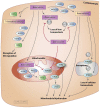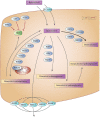Pharmacogenomics as a Tool to Limit Acute and Long-Term Adverse Effects of Chemotherapeutics: An Update in Pediatric Oncology
- PMID: 32848787
- PMCID: PMC7421781
- DOI: 10.3389/fphar.2020.01184
Pharmacogenomics as a Tool to Limit Acute and Long-Term Adverse Effects of Chemotherapeutics: An Update in Pediatric Oncology
Abstract
In the past decades, new cancer treatments have been introduced in pediatric oncology leading to improvement in clinical outcomes and survival rates. However, due to inter-individual differences, some children experience severe chemotherapy-induced toxicities or a poor clinical outcome. An explanation for the diversity in response to chemotherapy is genetic variation, leading to differences in expression and activity of metabolizing and transport enzymes as well as drug targets. Pharmacogenetic testing has emerged as a promising tool to predict and limit acute and long-term adverse effects in patients. However, in pediatric oncology, limited number of patients and a considerable diversity in study results complicate the interpretation of test results and its clinical relevance. With this review, we provide an overview of new developments over the past four years regarding relevant polymorphisms related to toxicity in pediatric oncology. The following chemotherapeutics and associated toxicities are discussed: alkylating agents, anthracyclines, asparaginase, methotrexate, platinum compounds, steroids, thiopurines, topoisomerase inhibitors, and vinca alkaloids. Our review identifies several questions regarding the role of genetic variants in chemotherapy-induced toxicities. Ambiguities in the literature stem from small population sizes, differences in (statistical) interpretation and variations in sequencing technologies as well as different clinical outcome definitions. Standardization of clinical outcome data and toxicity definitions within electronic health records combined with the increased availability of genomic sequence techniques in clinical practice will help to validate these models in upcoming years.
Keywords: adverse effects; chemotherapeutic agents; drug toxicity; pediatric oncology; pharmacogenomics.
Copyright © 2020 Bernsen, Hagleitner, Kouwenberg and Hanff.
Figures



Similar articles
-
Pharmacogenomics of chemotherapeutic susceptibility and toxicity.Genome Med. 2012 Nov 30;4(11):90. doi: 10.1186/gm391. eCollection 2012. Genome Med. 2012. PMID: 23199206 Free PMC article. Review.
-
The future of Cochrane Neonatal.Early Hum Dev. 2020 Nov;150:105191. doi: 10.1016/j.earlhumdev.2020.105191. Epub 2020 Sep 12. Early Hum Dev. 2020. PMID: 33036834
-
Cancer pharmacogenomics in children: research initiatives and progress to date.Paediatr Drugs. 2013 Apr;15(2):71-81. doi: 10.1007/s40272-013-0021-9. Paediatr Drugs. 2013. PMID: 23529868 Review.
-
Pharmacogenomics in Pediatric Oncology: Mitigating Adverse Drug Reactions While Preserving Efficacy.Annu Rev Pharmacol Toxicol. 2021 Jan 6;61:679-699. doi: 10.1146/annurev-pharmtox-031320-104151. Epub 2020 Sep 25. Annu Rev Pharmacol Toxicol. 2021. PMID: 32976737
-
Gene expression profiling for guiding adjuvant chemotherapy decisions in women with early breast cancer: an evidence-based and economic analysis.Ont Health Technol Assess Ser. 2010;10(23):1-57. Epub 2010 Dec 1. Ont Health Technol Assess Ser. 2010. PMID: 23074401 Free PMC article.
Cited by
-
Management and Clinical Outcome of Posterior Reversible Encephalopathy Syndrome in Pediatric Oncologic/Hematologic Diseases: A PRES Subgroup Analysis With a Large Sample Size.Front Pediatr. 2021 Jul 1;9:678890. doi: 10.3389/fped.2021.678890. eCollection 2021. Front Pediatr. 2021. PMID: 34277519 Free PMC article.
References
Publication types
LinkOut - more resources
Full Text Sources
Miscellaneous

